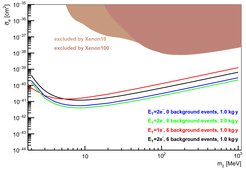DANAE
DANAE (Direct dArk matter detection using DEPFET with repetitive Non-destructive readout Application Experiment)
Dark matter is one of the big mysteries of modern physics. While several independent observations indicate the existence of Dark Matter and its existence is undisputed, its nature is still unknown [1], [2]. A possible explanation for Dark Matter is the existence of a new particle. Several experiments try to detect this new particle via direct measurements.
Dark matter should interact (weakly) with ordinary matter. A possible interaction is the scattering of a DM particle on an electron. Using a silicon sensor, the interaction will happen with a bound electron of the silicon itself. The challenge is that only a very small amount of energy is transferred to the electron, leading to a very small amount of charge generated within the silicon per interaction. To resolve these small signals a near noiseless sensor is required [3].
The limiting factor for conventional filtering techniques is usually 1/f noise in the detector system [4].

With a DePFET it is possible to implement a repetitive readout of the collected charge and overcome this limitation. Simply put, by averaging multiple measurements, the errors of the single measurements average out, following the central limit theorem. That way it is possible to detect and distinguish even single electrons generated within the silicon volume.
In the context of DANAE we will operate the first DePFET RNDR matrix. The goal is to demonstrate single electron resolution over the a 64x64 Pixel matrix. Provided this is successful the long-term goal is to operate a large volume silicon detector over several years to achieve a new sensitivity for dark matter detection [3].
References and further reading:
1) G. Bertone, D. Hooper and J. Silk, Phys. Rept. 405, 279 (2005) https://arxiv.org/abs/hep-ph/0404175
2) H. Baer, K.Y. Choi, J.E. Kim and L. Roszkowski, Phys. Rept. 555, 1 (2015)
3) A. Baehr, H. Kluck, J. Ninkovic, J. Schieck, J. Treis, „DePFET detectors for direct detection of MeV Dark Matter particles”, EPJ C 77 (12), June 2017, https://arxiv.org/abs/1706.08666
4) E. Gatti et. Al, “Suboptimal filtering of 1/f-noise in detector charge measurements”, Nuclear Instruments and Methods in Physics Research A297 (1990), 467-478
